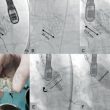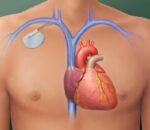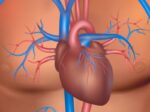Courtesy of Dr. Carlos Fava. Transcatheter aortic valve replacement (TAVR) has shown ample benefit in different groups, but one of its drawbacks continues to be the need for permanent pacemaker (PPM), which ranges between 5 and 30%. Its long term impact in terms of mortality is still controversial, since some studies associate it with...
Post TAVI pacemaker implantation does not increase mortality
Original Title: Impact of New-Onset Left Bundle Branch Block and Periprocedural Permanent Pacemaker Implantation on Clinical Outcomes in Patients Undergoing Transcatheter Aortic Valve Replacement. A Systematic Review and Meta-Analysis. Reference: Ander Regueiro et al. Circ Cardiovasc Interv. 2016 May;9(5). Available data on the clinical impact of the new-onset left bundle branch block (LBBB) and...
Less Paravalvular Regurgitation and More Pacemakers for the New Balloon Expandable Valve
Original Title: Changes in the Pacemaker Rate After Transition from Edwards SAPIEN XT to SAPIEN 3 Transcatheter Aortic Valve Implantation. The Critical Role of Valve Implantation Height. Reference: Fernando De Torres-Alba et al. J Am CollCardiolIntv. 2016, online before print. The aim of this study was to analyze pacemaker implantation rates with the new generation...
ADVANCE II: Low incidence of permanent pacemaker for self -expandable valve
The incidence of permanent pacemaker implantation (PPM) is variable between the different series within 30 days of the aortic valve implantation with the CoreValve prosthesis. The aim of this study was to investigate the conduction abnormalities and PPM according to the Conduction Disorders Guide. This multicentre prospective study with a follow-up to 7 days, 30...
The permanent pacemaker implantation after TAVI does not negatively impact on the results or even helps
Original title: Pacemaker implantation following transcatheter aortic valve implantation: Impact on late clinical outcomes and left ventricular function. Reference: Urena M et al. Circulation. 2014 Mar 18;129(11):1233-43. The need for permanent pacemaker implantation (PPI) is one of the most frequent complications associated with TAVI. Although data suggest that right ventricle stimulation has a potential negative impact, the...
Predilation with smaller valvuloplasty balloon diameter could reduce the need for permanent pacemaker after CoreValve
Original title: Reduction of pacemaker implantation rates alter CoreValve implantation by moderate predilatation Reference: Philipp Lange, et al. EuroIntervention 2014;9:1151-1159 Aortic valve implantation has been proven a valid strategy to treat high risk patients. The CoreValve self-expanding transcatheter aortic valve is associated with a relatively high rate of permanent pacemaker implantation and, until now, no efforts have been...
QRS after TAVI, The Best Predictor for safe transitory pacemaker removal
Original title: Patients Without Prolonged QRS After TAVI with CoreValve Device do not Experience High-Degree Atrio-Ventricular Block. Reference: Gauthier Mouillet et al. Catheterization and Cardiovascular Interventions 81:882–887 (2013). High degree atrioventricular block (AVB) in the context of transcatheter aortic valve implantation (TAVI) has been reported with variable incidence (3-45%) depending on the population characteristics and the kind of...
The need for pacemaker post TAVI does not change the prognosis
Original title: Impact of Permanent Pacemaker Implantation on Clinical Outcome Among Patients Undergoing Transcatheter Aortic Valve Implantation. Reference: Lutz Buellesfeld et al. J Am Coll Cardiol 2012;60:493–501 Although pacemaker implantation after a percutaneous aortic valve (TAVI) implantation, constitutes a significant proportion of the complications related to the procedure, this is generally considered a benign event. This study analyzed...
The impact of permanent pacemaker implantation in patients undergoing percutaneous aortic valve replacement.
Reference: Buellesfeld y colaboradores (JACC in press). Percutaneous aortic valve replacement (AVR) is an innovative technique for the treatment of severe aortic stenosis (SAS); this technique has been incorporated with great enthusiasm in clinical practice, particularly for patients with excessive surgical risks. Due to the proximity of the aortic valve, AV node and His bundle, there...
TAVR in Bicuspid Valves
Bicuspid aortic valve (BAV) disease affects 1%-2% of the population and manifests with severe aortic stenosis in the middle-aged. It characterizes for a very different anatomy with more calcification than the tricuspid aortic valve. At present, surgical aortic valve replacement (SAVR) is the first treatment indication. TAVR in this scenario has shown, in different studies,...








